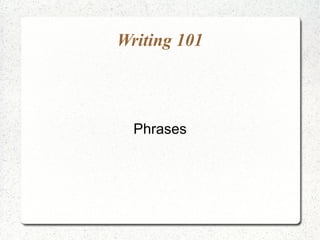
LL Upper Pri - Phrases
- 1. Writing 101 Phrases
- 2. Learning Objectives To understand how a phrase is formed. To enhance sentences using phrases.
- 3. Introduction Phrases are defined as: A group of words without a subject or verb or both. Note that if there's a subject AND a verb, a sentence is formed instead. 1) Sit up. 2) The garden city. 3) Can you sit up? 'Sit up' and 'The garden city' are phrases as they're either missing a subject or a verb. 'Can you sit up?' is a sentence as it has both.
- 4. Creating Phrases Creating Phrases is easy. With each Key Part of Speech, just add at least one more word to it. 1) city – garden city : Noun Phrase 2) give – give up : Phrasal Verb 3) big – big wooden : Adjectival Phrase 4) again – again and again : Adverbial Phrase Q: Can you think of a sentence for each of these phrases?
- 5. Sentences with Phrases Sentences with phrases have greater meaning. Please hand in your overdue English homework. (Adjectival Phrase and Noun Phrase) Don't you give up every now and then (Phrasal Verb and Adverbial Phrase) From 4 Key Parts of Speech, we have 4 key phrases – Noun, Adjectival, Verb and Adverbial phrases.
- 6. Phrases becoming Sentences With subjects AND phrases, sentences are formed: 1) Please hand in your homework. 2) Don't you give up. 3) You need to stand up. 4) She sits down.
- 7. Phrasal Verbs These phrases are used most commonly in a classroom. 1) Hand in. 2) Give up. 3) Stand up. 4) Sit down. These are phrases related to verbs or actions and hence, are called phrasal verbs.
- 8. Noun Phrases A noun phrase contains a head noun (highlighted). Adding words in front or behind create the phrase. 1) The Singapore skyline is beautiful. 2) My health-conscious and sporty friends enjoy a morning walk. 3) I could not find my way home. Q: Without the head noun, what would the underlined words be?
- 9. Adjectival Phrases An adjectival phrase has the function of an adjective, but longer. They describe the noun (highlighted). 1) Brinda is a very successful pianist. 2) My watch is quite cheap. 3) This is an extremely lovely gift. 4) The big red wooden table belongs to my sister. Like other phrases, an adjectival phrase gives the sentence greater meaning without using a connector.
- 10. Adverbial Phrases Adverbial phrases have the function of adverbs, but longer. They describe the verb's how, when, where or why. 1)The dancers performed extremely well. (how) 2)The dancers performed in the Esplanade. (where) 3)The dancers performed at the graduation cerermony. (when) 4)The dancers performed for the honoured guests. (why)
- 11. Learning Activity Identify the phrases that are underlined. 1) I shouted again and again. 2) The alert security guard chased the thief. 3) We build up a beautiful garden city. 4) We build up a beautiful garden city for everyone. 5) We build up a beautiful garden city. 6) We build up a beautiful garden city.
- 12. Learning Activity Answers Identify the phrases that are underlined. 1) I shouted again and again. (Adv) 2)The alert security guard chased the thief. (Adj) 3) We build up a beautiful garden city. (V) 4) We build up a beautiful garden city for everyone. (Adv) 5) We build up a beautiful garden city. (N) 6) We build up a beautiful garden city. (Adj)
- 13. Discussion What is a phrase What is its use? How do you create NAVA phrases?
- 14. In Summary A phrase is a group of words that do not form a complete sentence, missing a verb or a noun. A phrase is used to give a sentence greater meaning. We take the one key part of speech and expand it to two words or more.
